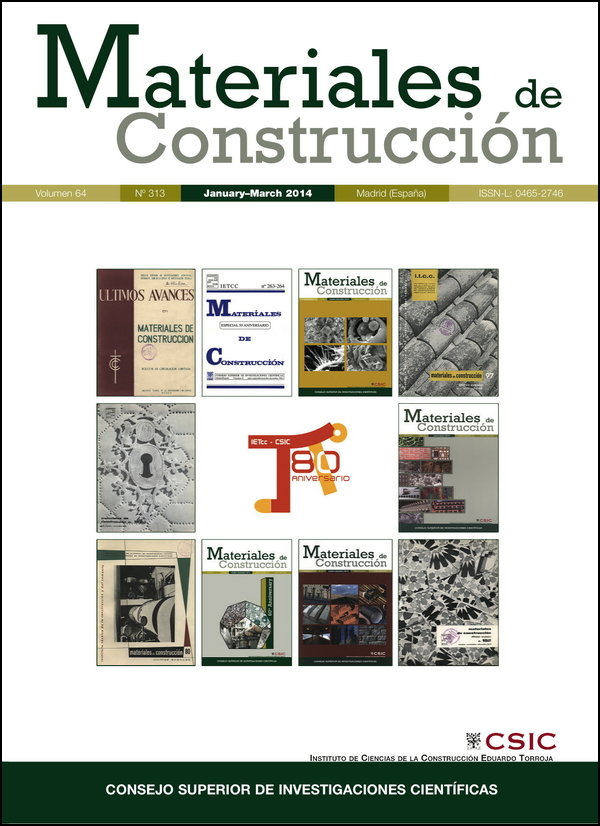A model for acoustic absorbent materials derived from coconut fiber
DOI:
https://doi.org/10.3989/mc.2014.00513Keywords:
Acoustic impedance, Absorption coefficient, Natural fibers, Empirical modelsAbstract
In the present paper, a methodology is proposed for obtaining empirical equations describing the sound absorption characteristics of an absorbing material obtained from natural fibers, specifically from coconut. The method, which was previously applied to other materials, requires performing measurements of air-flow resistivity and of acoustic impedance for samples of the material under study. The equations that govern the acoustic behavior of the material are then derived by means of a least-squares fit of the acoustic impedance and of the propagation constant. These results can be useful since they allow the empirically obtained analytical equations to be easily incorporated in prediction and simulation models of acoustic systems for noise control that incorporate the studied materials.
Downloads
References
1. Delany, M.E.; Bazley, E.N. (1970) Acoustical Properties of Fibrous Absorbent Materials. Appl. Acoust. 3, 105–116. http://dx.doi.org/10.1016/0003-682X(70)90031-9
2. UNE-EN 12354-6. (2004) Acústica en la edificación. "Estimación de las características de las edificaciones a partir de las características de sus elementos", parte 6, "Absorción sonora en espacios cerrados".
3. Miki, Y. (1990) Acoustical Properties of Porous Materials-Modifications of Delany-Bazley Models. J. Acoust. Soc. Jpn. (E) 11 [1], 19–24. http://dx.doi.org/10.1250/ast.11.19
4. Miki, Y. (1990) Acoustical Properties of Porous Materials-Generalizations of empirical models. J. Acoust. Soc. Jpn. (E) 11 [1], 13–24.
5. Dunn, I.P.; Davern, W.A. (1986) Calculation of acoustic impedance of multi-layer absorbers. Appl. Acoust. 19, 321–334. http://dx.doi.org/10.1016/0003-682X(86)90044-7
6. Garai, M.; Pompoli, F. (2005) A simple empirical model of polyester fibre materials for acoustical applications. Appl. Acoust. 66, 1383–1398. http://dx.doi.org/10.1016/j.apacoust.2005.04.008
7. Wang, X.; Eisenbrey, J.; Zeitz, M.; Sun, J.Q. (2004) Multi-stage regression analysis of acoustical properties of polyurethane foams. J. Sound Vib. 273, 1109–1117. http://dx.doi.org/10.1016/j.jsv.2003.09.039
8. Shoshani, Y.; Yakubov, Y. (2000) Numerical assessment of maximal absorption coefficients for nonwoven fiberwebs. Appl. Acoust. 59, 77–87. http://dx.doi.org/10.1016/S0003-682X(99)00015-8
9. Voronina, N. (1996) Improved Empirical Model of Sound Propagation through a Fibrous Material. Appl. Acoust. 48 [2], 121–132. http://dx.doi.org/10.1016/0003-682X(95)00055-E
10. Voronina, N. (1998) An Empirical Model for Elastic Porous Materials. Appl. Acoust. 55 [1], 67–83. http://dx.doi.org/10.1016/S0003-682X(97)00098-4
11. Voronina, N. (1999) An empirical model for rigid-frame porous materials with low porosity. Appl. Acoust. 58, 295–304. http://dx.doi.org/10.1016/S0003-682X(98)00076-0
12. Voronina, N.; Horoshenkov, K.V. (2003) A new empirical model for the acoustic properties of loose granular media. Appl. Acoust. 64, 415–432. http://dx.doi.org/10.1016/S0003-682X(02)00105-6
13. Asasutjarit, C.; Hirunlabh, J.; Khedari, J.; Charoenvai, S.; Zeghmati, B.; Cheul Shin, U. (2007) Development of coconut coir-based lightweight cement board. Constr. Build. Mater. 21 [2], 277–288. http://dx.doi.org/10.1016/j.conbuildmat.2005.08.028
14. Panyakaew, S.; Fotios, S. (2011) New thermal insulation boards made from coconut husk and bagasse. Energ. Buildings. 43 [7], 1732–1739. http://dx.doi.org/10.1016/j.enbuild.2011.03.015
15. Fouladi, M.H.; Nor, M.J.M.; Ayub, M.; Ali Leman, Z. (2010) Utilization of coir fiber in multilayer acoustic absorption panel. Appl. Acoust. 71 [3], 241–249. http://dx.doi.org/10.1016/j.apacoust.2009.09.003
16. Fouladi, M.H.; Ayub, M.; Nor, M.J.M. (2011) Analysis of coir fiber acoustical characteristics. Appl. Acoust. 72, 35–42. http://dx.doi.org/10.1016/j.apacoust.2010.09.007
17. Nor, M.J.M.; Jamaludin, N.; Tamiri, F.M. (2004) A preliminary study of sound absorption using multi-layer coconut coir fibers. EJTA, 3–8.
18. Nor, M.J.M.; Ayub, M.; Zulkifli, R.; Amin, N.; Fouladi, M.H. (2010) Effect of different factors on the acoustic absorption of coir fiber. J. Applied Sci. 10 [22], 2887–2892. http://dx.doi.org/10.3923/jas.2010.2887.2892
19. Zulkifli, R.; Nor, M.J.M.; Ismail, A.R.; Nuawi, M.Z.; Abdullah, S.; Tahir, M.F.M.; Rahman, M.N.A. (2009) Comparison of Acoustic Properties between Coir Fibre and Oil Palm Fibre. EJSR, 33 [1], 144–152.
20. del Rey, R.; Alba, J.; Sanchís, V. (2007) Proposal of an empirical model for absorbent acoustical materials based in kenaf. 19th International Congress on Acoustics (Madrid) 2–7 September 2007. PMCid:PMC2013696
21. Ramis, J.; Alba, J.; del Rey, R.; Escuder, E.; Sanchís, V.J. (2010) Nuevos materiales absorbentes acústicos basados en fibra de kenaf. Mater. Construcc. 60 [299], 133–143. http://dx.doi.org/10.3989/mc.2010.50809
22. ASTME1050. (2010) Standard Test Method for Impedance and Absorption of Acoustical Material Using a Tube, Two Microphones and a Digital Frequency Analysis System.
23. UNE-EN ISO 10534-2 (1998) Acústica. "Determinación del coeficiente de absorción acústica y de la impedancia acústica en tubos de impedancia", parte 2, "Método de la función de transferencia".
24. ISO 10534-2. (2002) Acoustics - Determination of sound absorption coefficient and impedance in impedance tubes - Part 2: Transfer-function method.
25. UNE-EN 29053. (1994) Acústica. Materiales para aplicaciones acústicas. Determinación de la resistencia al flujo de aire.
26. ISO 9053. (1991) Acoustics – Materials for acoustical applications. Determination of airflow resistance.
27. Ingard, K.U.; Dear, T.A. (1985) Measurement of Acoustic Flow Resistance. J. Sound Vib. 103, 567–572. http://dx.doi.org/10.1016/S0022-460X(85)80024-9
28. Bies, D.A.; Hansen, C.H. (1980) Flow resistance information for acoustical design. Appl. Acoust. 13, 357–391. http://dx.doi.org/10.1016/0003-682X(80)90002-X
Published
How to Cite
Issue
Section
License
Copyright (c) 2014 Consejo Superior de Investigaciones Científicas (CSIC)

This work is licensed under a Creative Commons Attribution 4.0 International License.
© CSIC. Manuscripts published in both the printed and online versions of this Journal are the property of Consejo Superior de Investigaciones Científicas, and quoting this source is a requirement for any partial or full reproduction.All contents of this electronic edition, except where otherwise noted, are distributed under a “Creative Commons Attribution 4.0 International” (CC BY 4.0) License. You may read here the basic information and the legal text of the license. The indication of the CC BY 4.0 License must be expressly stated in this way when necessary.
Self-archiving in repositories, personal webpages or similar, of any version other than the published by the Editor, is not allowed.


















